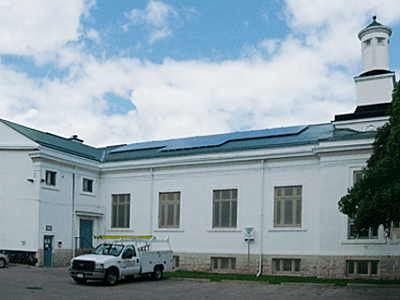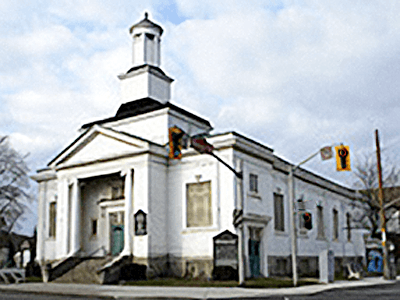About Us (cont'd)
. . . The more we got to know each other, the more our Worship became a deeper celebration. Helping each other be respectful of God’s creation, and enjoying each other’s company gave us a sense of friendship that allowed us to celebrate God’s provision for us, and believe our little world might be saved, after all. Even gathering for worship turned out to be green—in winter, we turn down our heat at home, and come to our Church—and everybody saves fuel—the same in the summer—we turn off the air conditioner at home, come to our air conditioned Church, and we all save energy, while getting energized by each other’s company and God’s presence.
Ideas just kept coming. Someone heard of a deal on Compact Florescent Lights. Everybody gathered their extra coupons, and we bought enough to replace seventy bulbs in our Church, and we are saving $50 a month on the hydro bill. We’ve also been able to put the big ladder in storage, because we don’t have to use it every other week to replace another burned out bulb. Someone else heard about free upgrades to the existing florescent lighting in the Church to T-8’s (high efficiency fluorescent lights), and our Utility Company did $1000 worth of free upgrades in our Church, and we did a little more upgrading, putting some LED lights in the old exit lights to reduce power usage. When our Church School wanted to decorate the sanctuary for Thanksgiving we made the effort to not get in cars, but to buy local, and went to our Ottawa Street Farmer’s market, and decorated with the vegetables we bought there. The children were instructed to buy things that could be eaten, and after the service (now annually), all those vegetables went to feed people at the Wesley Centre in Hamilton.

The ladies in the kitchen started defrosting their freezers, and reorganizing their fridge, and calling when they needed the stove pilots lit. In the Office, we started asking about how we could cut down on photo copies and paper. People who help us clean the Church don’t want us using all kinds of chemicals, so we started using fewer chemicals, and more elbow grease. We banned toilet pucks at Church when a toilet puck caught in the flapper valve, increasing our water usage substantially until it was found; and we’ve survived nicely without blue water in the toilets. When people kept cranking up the heat in the gym because they were cold, and when everybody saw the heat bill going up, we talked to each other, decided being cold wasn’t the answer, and talked to our heating contractor, who moved the heat ducts from the ceiling to the floor, setting up a convection current, and making the gym warmer and using less fuel.
We didn’t realize we were going green. We didn’t form a Green Team or anything like that. It just made sense for us to start thinking, all of us, together, about how to save money, and being green was saving us money, and time, and increasing the cooperation and affection we had for each other.
Some of the things we were told would be green, we didn’t do. They didn’t make sense. They cost more money and used more materials, and created more trash, and we couldn’t see the benefit. We learned that a stitch in time saves nine, and that the best idea is to be happy with what you have, and look after it well. Sometimes the solution is to not buy anything. When a carpet wore out at the northwest entrance, we lifted it up, and found a wonderful terra cotta floor installed in 1912, in perfect condition. We didn’t buy a new carpet. Soon people were asking why we didn’t have a handier way to recycle at the Church, and recycle bins were purchased and green carts arrived, and we worked with the City to get our recycling actually picked up instead of blowing up and down the street. That’s when we began to realize we were going green, and it felt good. Our Church Mission Statement: ‘with respect, cooperation and joy’ was turning out to be prophetic in ways we never imagined. Respect for each other’s ideas, respect for the earth, cooperating with each other, holding each other accountable, cooperating with our community; it was building us up and helping us express, in practical ways, love for God, for each other, and for God’s creation.We had been talking for years about an Accessible Entrance—usually involving an elevator. But we tried again, and found a better; more affordable way to make sure everyone could get into our Church. We had an architect design an atrium with ramps. It was designed to be green, and friendly to people who needed to use it—we learned that physically challenged people enjoy being in control of their mobility, and ramps give everyone the freedom to choose how to get where they’re going. The new addition would have skylights to reduce the need for lighting, and take advantage of ambient heat, so that the Church fuel bill would actually be reduced, instead of increased, by the new addition, with no big electric motors needed, and no expensive annual inspections and licences.
Then disaster struck. A section of our roof failed, suddenly. After a quick patch up, we got talking. The British style gutters were in trouble, and if they rotted out, they would be expensive to repair, impossible to replace. The asphalt shingles weren’t lasting very long. So we decided a steel roof was the right thing to do—we’re from Steel Town! The old asphalt can stay right where it is, a bit of insulation instead of a ton of landfill. The steel will last 70 or more years, and then be completely recyclable at the end of its life. The old flat roof will be peaked and covered with steel, so it stops demanding more asphalt every ten years. Our contractor found a way to reline the gutters with steel instead of asphalt, preserving them for another hundred years. Going green saves a lot of money—over the life of the new roof; we will save at least three replacements of those asphalt shingles.
This means that we, and our children, will have to raise about $130,000 less to look after our roof over the next 70 years. This going green turns out to be very smart, especially in the long run.
Only one problem remained. How are we going to pay for this new roof? While pondering that problem, the Minister (Rev. Doug Moore) took his family to the Peach Festival; his son wanted to hear the Five Man Electrical Band who was playing there. The thunder and lightning prevented hearing the band. But Dan Cole was there, with his solar panels set up. We talked, and a light came on. What if solar panels could generate enough income to pay for themselves and the new roof? Dan and Mike, from Direct Current (the solar panel company) checked out our place. They found a structural steel framed Church, and a south facing, unobstructed roof at around 43 degrees. It was ideal for solar panels. The Ontario Government in October 2009 came up with a plan to buy green power, giving us an opportunity to cooperate with the government and benefit ourselves!

Hamilton Conference, and then our Hamilton Presbytery and the Hamilton Presbytery Mission Council put us through our paces. It is to their credit that they had a lot of questions. But they listened to us, and they offered their permission, and when the banks wouldn’t help us, our Mission Council prodded us to get a business plan together. We found wonderful people willing to help us do this good thing, and they helped us express ourselves and make sense of the numbers. The numbers were very good. We have room for at least 25 kW of solar panels. If we install 10 kW, the income will be about $9,500 each year, enough to pay the loan for the roof and solar panels. Mission Council offered the loan we needed. Once we’re finished with the new roof and solar panels, we can get back to the Accessible Entrance.
We’re a worshipping community in East Hamilton; our lighthouse shaped steeple is a Beacon, welcoming all who would gather in respect, cooperation and joy, seeking the light of Jesus Christ. Now we realize we’re going green, and going green, for us, is about John 3:16—For God so loved the world—the way we see the world, it’s not about us and them. We believe Jesus came to teach us how to live with respect, cooperation and joy. We find our deepest joy being part of doing what needs to be done to save the whole world, not just us, not just the people, not just the planet—the whole world. That’s our sense of mission, and our source of joy and celebration.
It has been said: You can do very little with faith—and nothing without it.
Being called green has come as a surprise to us. We haven’t spent much time complaining about the state of the world, or ringing bells of alarm—we’ve been really busy. We are not inclined to tell other people what to do.
We still don’t have a Green Team. We became green when all of us, together, sought a balance between what we need to live, and what God has given us to live on. We learned to talk to each other, and listen to each other, and welcome new ideas, hold each other accountable, and connect with our community in ways we never imagined. We are grateful to be part of God saving the world God loves. We enjoy the light and power that we have the privilege to use now, and leave for the generations to come.
We look forward to the future. We’re a long way from finishing our journey. In many ways, we’ve just begun. The kindness and cooperation we’ve been privileged to receive obligates us to tell our story, even though it’s nowhere near finished. Learning to live with respect in God’s creation has transformed our faith community, and connected us with many new friends. We believe what we have done, and are doing, can be done by people of all kinds of faith and any sort of good will, anywhere on earth, and we hope our story inspires you to tell your story, for the good of this world God loves.

